The Coup in Saragossa
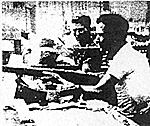 The Spanish Civil War began on the 17th July 1936 with a military rising led by Nationalist army generals against the Spanish Republican government. However, no one immediately joined them in Saragossa, the capital of Aragon and headquarters of the 5th Army Division. General Cabanellas, the Military commander there, had proclaimed his loyalty to the republic and declared a "state of siege" against any "fascist menaces." Unfortunately for the republicans, the leaders of the CNT, the Anarcho-Syndicalist union, and of the UGT, the Socialist union, were taken in by this proclamation and called upon their members to stay at home and called off their threatened general strike. This gullibility on the part of the union leaders gave General Cabanellas the time he needed to prepare a rising in Saragossa for the Nationalists. Although claiming to be a freemason and republican, he had decided that his best interests lay in siding with the rebels. The day of the 18th July was therefore spent incorporating Falangists (members of the Spanish Fascist movement) and civilian sympathisers into the security forces.
The Spanish Civil War began on the 17th July 1936 with a military rising led by Nationalist army generals against the Spanish Republican government. However, no one immediately joined them in Saragossa, the capital of Aragon and headquarters of the 5th Army Division. General Cabanellas, the Military commander there, had proclaimed his loyalty to the republic and declared a "state of siege" against any "fascist menaces." Unfortunately for the republicans, the leaders of the CNT, the Anarcho-Syndicalist union, and of the UGT, the Socialist union, were taken in by this proclamation and called upon their members to stay at home and called off their threatened general strike. This gullibility on the part of the union leaders gave General Cabanellas the time he needed to prepare a rising in Saragossa for the Nationalists. Although claiming to be a freemason and republican, he had decided that his best interests lay in siding with the rebels. The day of the 18th July was therefore spent incorporating Falangists (members of the Spanish Fascist movement) and civilian sympathisers into the security forces.
They struck at dawn the next day, with soldiers, Civil Guards and Falangists seizing stategic points throughout the city centre, setting up field guns and machine gun posts at all important road junctions. While the radio was announcing that the army was not marching against the republic and that the workers' demands would be respected, police were arresting union leaders, and the Republican Civil Governor was replaced by the commander of the Civil Guard.
General Strike
The CNT and UGT reacted quickly by calling a general strike in response to the seizure of the city centre by the army. However, morale was low as there was not enough time to mobilise before the rebels would be able to consolidate their positions. In the suburbs, attempts were made both to barricade the streets and to assemble armed forces, but as onlt a minority had been in favour of taking up arms before the rising, few preparations had been made for armed conflict. The CNT had considered the capture of Saragossa by the rebels as very unlikely, especially considering the influence of the libertarian movement in the city. Despite their low morale and a force made up of members of the Libertarian Youth was gathered and to a certain extent armed, though it was ambushed by the Civil Guard and put to flight with heavy losses.
With their failure to defeat the rebels by force of arms, those opposed to the Nationalist rising now had to hope for the success of their general strike. It is to their credit that for four days virtually all of Saragossa was at a standstill. The Nationalists had to scour the working class areas to drag out workers in key services and force them back to work. A number of railwaymen were shot for not complying with the order to return to work, and Union leaders were tortured in an unsuccessful attempt to make them call off the strike.
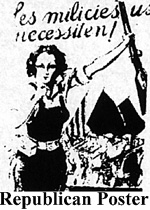 However, the workers could not keep up the pressure indefinitely and cracks soon appeared in their ranks. This was partly due to the fact that both communications and organising were virtually impossible, as the rebels now had almost total control over the city. The UGT were negotiating with the military, though to no avail. On the 23rd July the printers returned to work, and the Nationalists managed to send a train to Pamplona, which returned the next day with a body of Requetes (the ultra-Catholic Carlist militia). By the 28th, due to falling morale and hunger, a large number of people had returned to work including the tram workers and many railworkers. However, it was not until the 4th August that the general strike was finally called off and the Nationalists gained full control over the industries of Saragossa.
However, the workers could not keep up the pressure indefinitely and cracks soon appeared in their ranks. This was partly due to the fact that both communications and organising were virtually impossible, as the rebels now had almost total control over the city. The UGT were negotiating with the military, though to no avail. On the 23rd July the printers returned to work, and the Nationalists managed to send a train to Pamplona, which returned the next day with a body of Requetes (the ultra-Catholic Carlist militia). By the 28th, due to falling morale and hunger, a large number of people had returned to work including the tram workers and many railworkers. However, it was not until the 4th August that the general strike was finally called off and the Nationalists gained full control over the industries of Saragossa.
Although it had successfully slowed down the rebel's consolidation of power in Saragossa and the surrounding areas, the general strike had failed to bring about any decisive results. Republicans and unionists in the city now started to look to the militias of Catalonia to liberate them. Republicans had started leaving Saragossa in small numbers almost as soon as the military had risen in the city centre, and they now hoped to organise forces to take the city from outside. For although the rebels had successfully taken not just Saragossa, the capital of Aragon, but also Huesca, Calatayud, Jaca and Teruel, they were cheered by the fact that the rebels were being resisted in a number of places.
Assault Repulsed
An assault on Epila by Falangists on the 19th was sussessfully repulsed by CNT members, though the defenders were forced to withdraw on the 20th when the Falangists returned with a body of Civil Guards. In the countryside there were attempts to form militias in the area west of Saragossa in Aranda de Moncayo, Jarque and Arandiga. Civil Guards were beseiged for several hours in Terner before they were relieved by a force from Calatayud, which itself had seen some fighting. CNT members stormed a Civil Guard post at Gurrea de Gallego, killing four Civil Guards, and they also blew the bridge over the river Soton, which was closed for a week. However, on the 23rd a column arrived from Saragossa and stormed the village after a seven hour battle during which the mayor was killed.
The survivors from the fighting at Gurrea de Gallego withdrew to Almudebar on the Huesca-Saraggaso road where they again took up positions, though they could not withstand the artillery used against them. In both Huesca and Teruel general strikes had been proclaimed and resistance in both towns did not end until the 27th, with rail communications between both towns not being reopened until the following day. There was also fighting in the Cinco valley north of Saragossa, at Gallur and Pradilla in the Ebro valley, at Cincovillas, Albalate and Alarcon. The only town where the army remained loyal to the Republic was in Barbastro, where General Villalba was in command. However he was in no position to launch any offensives against the Nationalists in Saragossa.
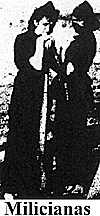 The problems that Republicans faced in Aragon following the fall of Saragossa were the lack of recruits to those forces that were raised (due to the shattering effect the fall of Saragossa had on their morale), the lack of communication between different groups (largely due to the chaotic situation of the fighting in Spain in the first days of war), and the lack of arms and ammunition. Those who were fighting to the north and west of Saragossa were effectively on their own as they were cut off from Republican units to the south of the city. It was only with the arrival of forces from the larger towns that the war became a war of fronts rather than a series of local conflicts.
The problems that Republicans faced in Aragon following the fall of Saragossa were the lack of recruits to those forces that were raised (due to the shattering effect the fall of Saragossa had on their morale), the lack of communication between different groups (largely due to the chaotic situation of the fighting in Spain in the first days of war), and the lack of arms and ammunition. Those who were fighting to the north and west of Saragossa were effectively on their own as they were cut off from Republican units to the south of the city. It was only with the arrival of forces from the larger towns that the war became a war of fronts rather than a series of local conflicts.
On the other hand the Nationalists in Saragossa had some problems of their own. Despite their success in taking the city with minimal losses, they lacked reliable troops. Much of the 5th Division had to be confined to barracks until the city was secured, while the Carlist requetes who had risen in Navarre to the north had plenty of men but too few arms. General Cabanellas therefore arranged an exchange of arms for men with the Carlists of Pamplona. They were sent 10,000 rifles in return for 1,500 Carlists, who started arriving in Saragossa from the 24th July. With the reopening of the Pamplona-Saragossa railway on the 23rd July, the Nationalist position in north eastern Spain became far more secure. Apart from the force of Carlists, General Cabanellas had under his command 4,000 men of the 5th Division, 18 companies of Civil Guards ard Carabineers, 2,000 Falangists led by the fanatical Jesus Muro and a further 1,00 civilian volunteers. Although they had crushed virtually all local resistance, they now had to face the far larger forces advancing towards them from Catalonia and the area of Valencia, which had not fallen to the rebels.
Events in Neighboring Catalonia
The Nationalist rising in Barcelona began on the morning of the 19th July. Despite having most of the army on their side, they were met with heavy resistance by members of the CNT-FAI (Federacion Anarquista Iberica) when they attempted to march into the city centre. When the bulk of the police force sided against the Nationalists in the afternoon, the rising was doomed. Many police even gave away their pistols to people who were resisting the Nationalists. Although the police were 1argely sympathetic to the rebellion, the huge numbers of people in the streets actively resisting the army convinced them that the rising couldn't succeed. By the end of the next day the rising was over, and General Goded, the Nationalist commander, was in Republican hands.
With the Nationalist defeat, the revolution began. Nationalist activists and sympathisers were arrested and large numbere were executed. Many churches and properties held by known rebels were either burnt or taken over by the workers'organisations. However, news soon came through that the Nationalists had been successful in Saragossa, and it was quickly resolved to go to the aid of their comrades there. This resolve was strongest among members of the libertarian movement, who were shocked by the loss of what they considered to be their stronghold.
Central Committee
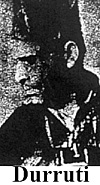 On the 20th July, the main republican and workers' organisations, led by the CNT-FAI, formed the Central Committee Of Anti-Fascist Militias. The Central Committee was to be responsible for policing, border control, and the organisation of forces to defeat the Nationalists in those places where their rising had been successful. As the fighting in Barcelona was coming to an end, some members of the CNT were already planning a campaign to liberate Aragon. Buenaventura Durruti, Juan Garcia Oliver, Diego Abad de Santillan and other famous Anarchist militants played a leading role in preparing the invasion plans.
On the 20th July, the main republican and workers' organisations, led by the CNT-FAI, formed the Central Committee Of Anti-Fascist Militias. The Central Committee was to be responsible for policing, border control, and the organisation of forces to defeat the Nationalists in those places where their rising had been successful. As the fighting in Barcelona was coming to an end, some members of the CNT were already planning a campaign to liberate Aragon. Buenaventura Durruti, Juan Garcia Oliver, Diego Abad de Santillan and other famous Anarchist militants played a leading role in preparing the invasion plans.
The invasion force was to be composed of four main columns, three of which would be organised by the CNT. The fourth was to comprise members of the Esquerra (Catalan Nationalists), POUM (Anti-Stalinist Communists) and PSUC (United Socialist Party of Catalonia). The idea was for one column, led by Durruti, to open up the way to Saragosso by attacking on the line Pina-Osera. Another Anarchist column, the Rojo y Negro, was to cut communications between Calatayud and Saragossa, and then to give support to the main assault on Saragossa. The third force, made up of the POUM, PSUC, and Esquerra contingents was to cut communications between Huesca and Saragossa. The fourth (Ascaso) column, another Anarchist force, was to launch an enveloping frontal attack on Huesca.
While the bulk of these columns were made up of civilian volunteers, both male and female, all of them had regular soldiers and police in their ranks. They also all had high ranking soldiers as advisors to their leaders. For instance, Durruti's military advisor was Major Perez-Farras, the head of the Barcelona police. Antonio Ortiz a carpenter, was leader of the Rojo y Negro Column, and had Major Fernando Salavera Compes as his advisor. While this may at first seem rather strange, especially in the case of Durruti, the seriousness of the situation forged some unlikely alliances. The Ascaso Column contained the largest group of regular soldiers, as the survivors from the regular Montana Battalion joined it. This column was led jointly by Gregorio Jover and Domingo Ascaso.
However, not everyone could wait for these columns to be raised, organised, and equipped. Manuel Prieto, an Anarcho-Syndicalist who had taken part in the FAI's 1932 rising in Catalonia, was impatient to set off for Saragossa straight away. On the 21st July he left Barcelona at the head of a small body of volunteers. Unfortunately for them, they were ambushed by Civil Guards at Pina de Ebro, and all were killed. There were other groups, especially of members of the libertarian youth (Federacion Iberica de Juventudes Libertarias), who set off in requisitioned vehicles, including American saloon cars.
Organization
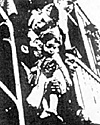 The forces being raised in Barcelona were very different to those of a regular army. The republican forces were organised both from above and below. From above, by appeals from union heads and political parties for volunteers to enroll in the columns. From below, through the self-organisation of groups of friends, work colleagues, neighbours and political associates. These groups would arm themselves, and either make their own way to the front, or enroll together in one of the columns. This self-organisation was largely a result of the fact that many of them had already been fighting for several days and had grouped themselves together in the process.
The forces being raised in Barcelona were very different to those of a regular army. The republican forces were organised both from above and below. From above, by appeals from union heads and political parties for volunteers to enroll in the columns. From below, through the self-organisation of groups of friends, work colleagues, neighbours and political associates. These groups would arm themselves, and either make their own way to the front, or enroll together in one of the columns. This self-organisation was largely a result of the fact that many of them had already been fighting for several days and had grouped themselves together in the process.
The Republican columns which set out from Catalonia have been estimated to have been about 20,000 strong. These consisted of approxonately 13,000 CNT members, 3,000 Poumistas, 2,000 UGT members, and 2,000 police and regular soldiers. There was also a unit organised by the Communist party, which was about 1,200 strong, but this did not leave for the front until a few days after the rest.
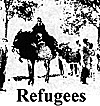 However, these figures blur out the fact that people did not necessarily join the unit which their organisation was forming. For instance, CNT and UGT members could well be found fighting in the same unit, especially in the chaotic days at the start of the war. Likewise, policemen and regular soldiers could be found in the Anarchist columns.
However, these figures blur out the fact that people did not necessarily join the unit which their organisation was forming. For instance, CNT and UGT members could well be found fighting in the same unit, especially in the chaotic days at the start of the war. Likewise, policemen and regular soldiers could be found in the Anarchist columns.
As to the quality of the militia columns, the vast majority had taken part in the struggle for Barcelona, and had therefore already seen the horrors of war at close hand. It has been estimated that approximately 10% of the militiamen were soldiers from the regular army. Nevertheless, their experience of warfare was not much greater than anyone else's. They did, hovever, inspire confidenec amorng the ranks, and if trusted politically, would be looked to for advice.
While the people in arms had been able to crush the military revolt in the city of Barcelona, fighting in open country was a totally different matter. As a result, they suffered many casualties in ill conceived attacks made across open ground. Still, in these early days of war tbe Republicans' morale and fighting spirit was very high, and they were determined to reach and take Saragossa. This fighting spirit was especially evident among the CNT-FAI members of the Durruti Column.
Weapons
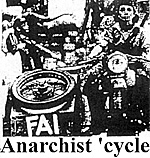 Heavy weapons were in short supply from the start. Ammunition stocks were also low as so much had been used up in the struggle for Barcelona. Moreover, there was at that time no armaments industry in Catalonia. It was quickly realised that if they were not to run out of ammunition, they would have to create an armaments industry themselves. Union members undertook the task of switching production to meet the needs of war. For example, the Hispano-Suiza factory, which was under CNT control, produced and sent 15 armoured vehicles to the front in the first week of war. They also produced hand grenades, ambulances, machine gun tripods and rests, and were considering the production of artillery shells.
Heavy weapons were in short supply from the start. Ammunition stocks were also low as so much had been used up in the struggle for Barcelona. Moreover, there was at that time no armaments industry in Catalonia. It was quickly realised that if they were not to run out of ammunition, they would have to create an armaments industry themselves. Union members undertook the task of switching production to meet the needs of war. For example, the Hispano-Suiza factory, which was under CNT control, produced and sent 15 armoured vehicles to the front in the first week of war. They also produced hand grenades, ambulances, machine gun tripods and rests, and were considering the production of artillery shells.
Hand grenade production soon reached 500 a day, though it is not clear whether they were of good quality or the feeble "Lafitte" type. Vallejo of the CNT visited many factories trying to co-ordinate the production of armoured vehicles, and also to bring together those people who had the best ideas on how to build good quality armoured vehicles. The early vehicles were built with plenty of enthusiasm but with little technical design, and Vallejo set about trying to change this.
Political Rivalry
Another problem which beset the militia columns and which reduced the number of weapons available was the political rivalry between the various parties and unions. This led to large numbers of rifles and machine guns being kept in the rear. Some weapons which were stored in Sabadell by the PSUC were requisitioned by members of the Durruti Column and taken to the front. Even in 1937, after nine months of war, many of the militia columns were still starved of large numbers of good quality weapons. Re-supplying the columns was an extremely difficult task for each unit would have a large variety of types of rifle, of differing calibres and ages. For those without weapons, many would either return to their home towns or work on the farms in their locality. For example, in Aug-Sep 1936, 25% ofthe Durruti Column were helping bring in the harvest on Aragonese farms.
However, the keeping of arms in the rear was not solely for the purpose of resolving political squabbles. Each union and political centre kept its own arms, but for a variety of reasons. It was difficult for may people who had fought in the street fighting in Barcelona to give up their arms, as there was some worry of a Nationalist landing in Catalonia. Fear of the Moors was widespread, and everyone wanted a weapon to defend themselves with. Likewise, many arms were collected to help prepare columns to aid in the defense of other areas of Spain, and more importantly, to take part in the proposed invasion of the Balearic Isles. The Central Committee was even discussing the possibility of provoking a rebellion in Morocco, and of sending the Moroccans arms to assist them in this.
Back to Abanderado Vol. 1 Compendium Table of Contents
Back to Abanderado List of Issues
Back to MagWeb Master Magazine List
© Copyright 1995 by Rolfe Hedges
This article appears in MagWeb (Magazine Web) on the Internet World Wide Web. Other military history articles and gaming articles are available at http://www.magweb.com